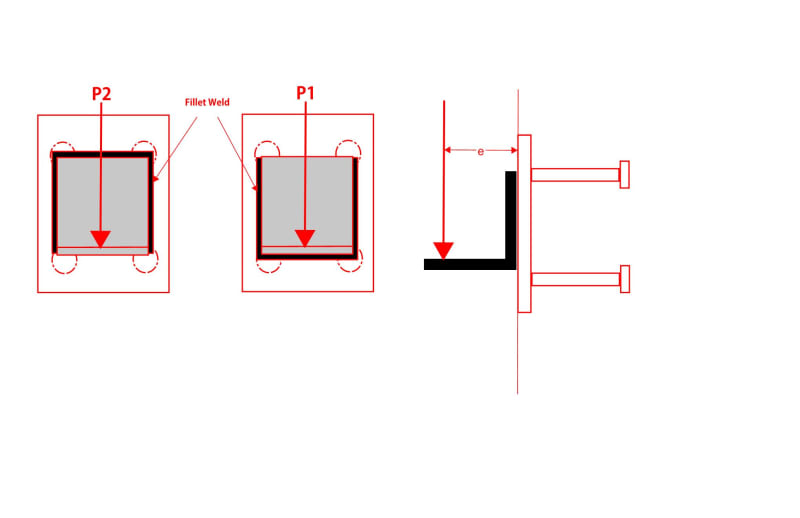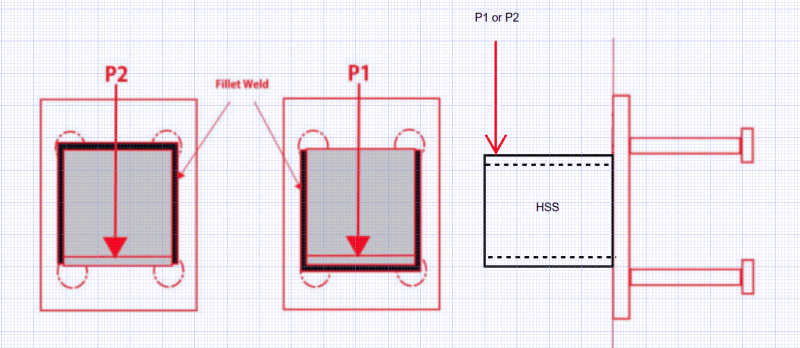-
1
- #1
Navigation
Install the app
How to install the app on iOS
Follow along with the video below to see how to install our site as a web app on your home screen.
Note: This feature may not be available in some browsers.
More options
Style variation
-
Congratulations cowski on being selected by the Eng-Tips community for having the most helpful posts in the forums last week. Way to Go!
You are using an out of date browser. It may not display this or other websites correctly.
You should upgrade or use an alternative browser.
You should upgrade or use an alternative browser.
Welding Capacity Calculation 7
- Thread starter JohnRwals
- Start date
- Status
- Not open for further replies.
CANPRO said:P2 would be better if you could flip the angle and put the vertical leg down and keep the weld on top.
Lomarandil said:I agree P2 with the angle flipped (or stiffened) is the highest capacity configuration.
Do not agree with these statements if your going to rely on the compression development between the angle and the embed then flipping the angle so the flexible leg vs the rigid heel works to develop the compression block is an inherently worse condition.
My Personal Open Source Structural Applications:
Open Source Structural GitHub Group:
Lomarandil
Structural
You think so Celt? I think your concern might be analogous to a concrete beam -- even if the leg is flexible and decreases the moment arm to the compression/bearing region, that's of less effect than the much larger area of weld (rebar) stressed in tension.
(For clarity, my comment is dealing entirely with the moment eccentric to the embed face. I'm not concerned here with the shear parallel to the face.)
----
just call me Lo.
(For clarity, my comment is dealing entirely with the moment eccentric to the embed face. I'm not concerned here with the shear parallel to the face.)
----
just call me Lo.
By this same logic you wouldn't develop any compression bearing with the embed until the vertical welds start to fail. Under the assumptions of an elastic analysis the strain at the tip of the vertical welds is constant across the horizontal weld so the weld experiences stress.CANPRO said:For P2, I don't think the horizontal weld is fully effective until the vertical welds start to fail. Think about how the angle has to deform to deliver load to the horizontal weld...you would develop separation between the angle and embedded plate, which can't happen because of the vertical weld.
agree, however in my experience more often than not the embed plate is askew and the angle seat is constructed with some small gaps filled with weld material. So so you'd need to work thru the weld deformation prior to engaging the plate in bearing, so the conservative design capacity would only consider the welds effective, then I have the bearing compression block as back pocket help if needed.CANPRO said:For P1, the horizontal weld does nothing if the angle is placed firmly against the embedded plate
If we are talking about field welds absolutely agree, if were talking about a shop weld the weld to the angle toe probably requires more material as its flare bevel weld because the toe fillet vs standard fillet at the right angle heel. If this is Bent plate and not an angle then I am in full agreement with your statement.DIK said:and to reiterate... it's easier to weld... seems like a win win situation.
My Personal Open Source Structural Applications:
Open Source Structural GitHub Group:
Lomarandil
Structural
R13, your illustration shows all that is needed (I haven't checked your math).
For load in the downward direction, parts in initial contact, and a sufficiently stiff angle (which may or may not be present), the peak tensile stress is at the top of the weld group.
As you illustrate, because of the neutral axis location, the tensile stress (stress=M/S) at the top is lower for the "P2" configuration (your 0.023 when using a unit moment) than P1 (0.035)
As a general rule, I'm rarely concerned with the compressive stress in cases like this because of the possibility of bearing between the angle and embed plate (e.g. the weld isn't loaded). So I would check the combined tensile and shear stress at the top of the group and call it a day.
(Of course, some rare geometries and/or applications will change the validity of that last statement.)
----
just call me Lo.
For load in the downward direction, parts in initial contact, and a sufficiently stiff angle (which may or may not be present), the peak tensile stress is at the top of the weld group.
As you illustrate, because of the neutral axis location, the tensile stress (stress=M/S) at the top is lower for the "P2" configuration (your 0.023 when using a unit moment) than P1 (0.035)
As a general rule, I'm rarely concerned with the compressive stress in cases like this because of the possibility of bearing between the angle and embed plate (e.g. the weld isn't loaded). So I would check the combined tensile and shear stress at the top of the group and call it a day.
(Of course, some rare geometries and/or applications will change the validity of that last statement.)
----
just call me Lo.
Lo said:even if the leg is flexible and decreases the moment arm to the compression/bearing region, that's of less effect than the much larger area of weld (rebar) stressed in tension.
If you go with this analogy a smaller moment arm begets larger tension/compression couple forces required for equilibrium which results in higher tensile stresses in the weld.
My Personal Open Source Structural Applications:
Open Source Structural GitHub Group:
Lo said:R13, analyzing stresses in a weld group as equivalent couple forces is not a correct approach.
The method used was the classic elastic method for stress analysis, with the weld treated as a line. I don't know another method/approach, and would like to learn. Can you share, please.
lo said:As a general rule, I'm rarely concerned with the compressive stress in cases like this because of the possibility of bearing between the angle and embed plate (e.g. the weld isn't loaded). So I would check the combined tensile and shear stress at the top of the group and call it a day.
You are entitled to your approach, but it's something I wouldn't do - weld the tension side only. Is this statement sounds "incorrect" or "misleading", please advise.
The weld design will be done by 2 steps without calculating all that properties and stresses - weld for tension, and weld for shear. But this forum is not the place to advocate for design short cuts, unless it is a discussion between two members that fully aware what they are talking about. When you want to criticize somebody else's comment, it's fine, but please be clear, don't play opinionated/sentimental word games.
EZBuilding
Structural
BAretired.
P2 would carry more load because P1 would probably be on the floor!
P2 would carry more load because P1 would probably be on the floor!
BA said:Suppose we eliminate the vertical welds in P1 and P2. Which carries more load?
P2 carries more because P1 will carry zero. P1 would pivot on the horizontal weld.
Celt83, I saw your reply to my comment...pretty busy so I didn't read over that closely, but I hope to later.
-
1
- #34
EZBuilding said:P2 would carry more load because P1 would probably be on the floor!
Okay, so the horizontal weld in P2 is better placed than the one in P1; so why is this not still true when vertical welds are added?
BA
r13 said:How about take away the horizontal weld for both case, which one is better?
They would be identical, r13, so the failure loads would be the same.
BA
It boils down to if you want to consider bearing compression development between the beam (angle, HSS, etc.) and the embed. I'm of the opinion that the load-deformation response of a weld is such that if you have even a 1/16" of separation you need to rely on just the weld for the load transmission.
If you allow compression bearing development:
P2 will always result in the higher capacity
If you do not rely on compression development between the beam and embed and define failure as weld rupture:
P2 and P1 have equal design capacity
P2 is ultimately a safer condition because after you reach the failure criteria of the vertical weld lines in compression you then have the additional redundancy of the compression bearing development creating an additional load equilibrium condition.
My Personal Open Source Structural Applications:
Open Source Structural GitHub Group:
If you allow compression bearing development:
P2 will always result in the higher capacity
If you do not rely on compression development between the beam and embed and define failure as weld rupture:
P2 and P1 have equal design capacity
P2 is ultimately a safer condition because after you reach the failure criteria of the vertical weld lines in compression you then have the additional redundancy of the compression bearing development creating an additional load equilibrium condition.
My Personal Open Source Structural Applications:
Open Source Structural GitHub Group:
Celt83 said:BA[/color]]It boils down to if you want to consider bearing compression development between the beam (angle, HSS, etc.) and the embed. I'm of the opinion that the load-deformation response of a weld is such that if you have even a 1/16" of separation you need to rely on just the weld for the load transmission. What can I say, other than I don't agree? No one is going to leave a gap between angle and embed plate.
If you allow compression bearing development:
P2 will always result in the higher capacity. Correct
If you do not rely on compression development between the beam and embed and define failure as weld rupture:
P2 and P1 have equal design capacity. Perhaps, but how many engineers would do that?
P2 is ultimately a safer condition because after you reach the failure criteria of the vertical weld lines in compression you then have the additional redundancy of the compression bearing development creating an additional load equilibrium condition. Indeed!!
BA
- Status
- Not open for further replies.
Similar threads
- Replies
- 8
- Views
- 14K
- Replies
- 7
- Views
- 3K
- Replies
- 56
- Views
- 16K
- Locked
- Question
- Replies
- 9
- Views
- 2K
- Replies
- 8
- Views
- 5K


